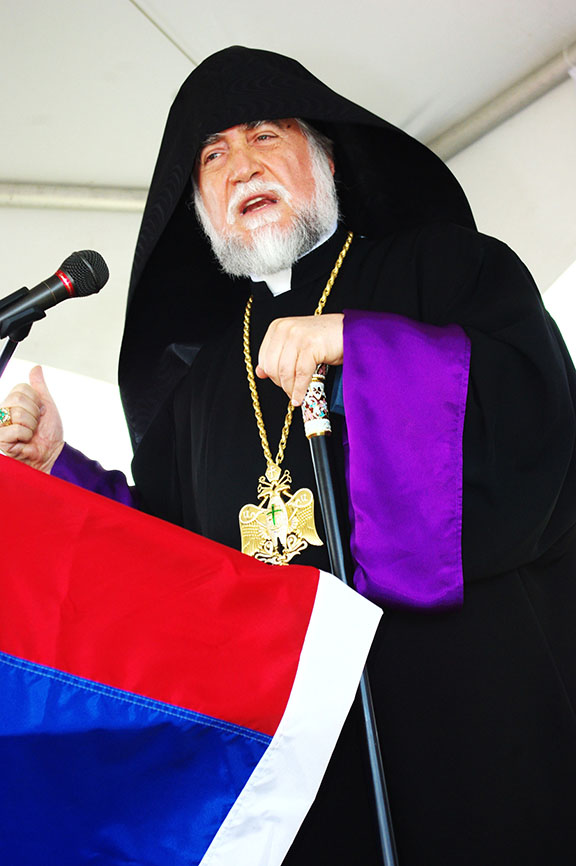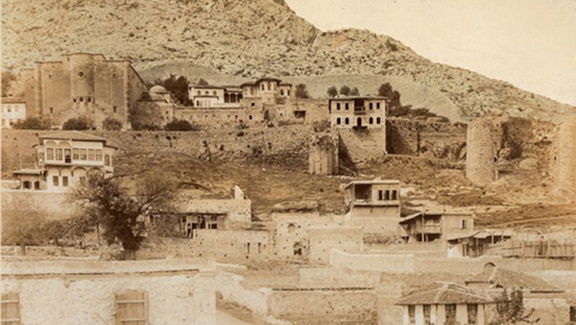
His Holiness Aram I, Catholicos of the Great House of Cilicia
BY VANNA KITSINIAN, ESQ.
At first glance, it may seem surprising that a man of the cloth would pursue a legal case that has rightly been referred to as “ground-breaking in nature.” However, when considering that the man is His Holiness Catholicos Aram I, it comes as no surprise.
On April 28, 2015, the Catholicosate of the Great House of Cilicia filed a lawsuit in the Turkish Constitutional Court to regain ownership of the historic headquarters of the Church, including the Catholicosate, the monastery, and the cathedral of St. Sophia located in Sis (present day Kozan), in south central Turkey’s Adana Province. The Sis Catholicosate was once the capital of Cilician Armenia.
The Catholicosate of Cilicia had moved to Sis in 1295 in order to accompany its people escaping the Seljuk atrocities in Armenia, and settled on the land now the subject of the lawsuit, where it stayed for over six centuries. During the Armenian Genocide, the population of Sis was massacred and deported, along with the 1.5 million Armenians who were killed or deported in the surrounding regions. In 1921, the Ottoman authorities illegally appropriated the headquarters and ordered the then-Catholicos to go into immediate exile. Many Christian holy sites were pillaged and confiscated and naturally, the deportation disconnected the church from its spiritual center in Sis. Last year, after lengthy consultations with international law experts and Turkish attorneys, Catholicos Aram I decided to reclaim ownership of these sacred religious properties and lands where Armenians had lived peacefully for centuries. With that bold and brave move, the first property case of this nature, for the return of religious properties to their original owners, was filed.

The former headquarters of the Catholicosate of the Great House of Cilicia of the Armenian Apostolic Church in Sis
In the landmark case, the claim of the Catholicosate is that it retains ownership rights over its historic Seat and that under international law and the 1923 Lausanne Treaty, the government of Turkey has an obligation to return this property so that it may be restored and used as it had been for over a 1,000 years – as a place of religious worship. His Holiness Aram I’s commitment to the case is based on his deep desire to convey “more than memory” to the coming generations by securing in a very concrete way the return of the Armenian Nation’s spiritual headquarter and heritage.
The return of the historical Seat of the Cilician Catholicosate is an opportunity for the Turkish government to demonstrate their respect for human rights and an even more timely chance to perform an act of justice and embark on a process of reconciliation with Armenia. On numerous occasions in the past, His Holiness Aram I has stressed that true reconciliation between Turkey and Armenia can only be based on recognition and reparations. He has made powerful remarks in international forums such as the World Council of Churches and before other global bodies that Armenians are on a quest to remember the martyrs of the Armenian Genocide, remind the world of the sacred legacy of our martyrs, and claim justice for the crimes committed against humanity.
If one closely follows His Holiness’ sermons, it’s clear that Catholicos Aram I’s act of taking legal action is very much aligned with his deeply-rooted belief in biblical teaching and his personal convictions in that it is the pure pursuit of justice. His Holiness has explained that the concept of justice is a gift of God and rejection of justice is a sin against God. He believes that according to the teachings of all religions, justice is at the core of human rights and that if we are to respect human rights, as we ought to do, we must likewise reject injustice.
In 2005, in his report to the Central Committee of the World Council of Churches, His Holiness focused his message on the concept of healing. He discussed healing as the transforming, empowering, and reconciling missionary action of the church. Healing, he stated, belongs to the very esse of the church and at the core of its mission because it is rooted in God’s revelation in both the Old and New Testament. He stated, “From the Christian perspective, the path towards justice and reconciliation requires the recognition of the crime committed as a sine qua non condition for the healing of memories and the possibility of forgiveness. Forgiveness does not mean forgetting but to look back with the intention to restore justice, the respect for human rights and relationship between perpetrators and victims.” As the Bible states, “the truth frees us, the truth liberates us,” and therefore, a first step to embarking on the path of reconciliation is to accept the truth.
As a result of truth telling, he has declared, healing is generated. As His Holiness has explained, although the living generation today did not directly experience the tragic past, the Armenian Genocide has had a strong impact on our spiritual and intellectual formation. The past haunts the victims, who cannot free themselves from the past unless the past is duly recognized. He continued, “Healing requires that the silence be broken and the truth be allowed to come to light. It allows for recognition of what has been hidden.”
As a transforming power, he has said, healing is the beginning of a new life in Christ and is the restoration of the brokenness of life. Catholicos Aram I described healing as the recovery of life’s wholeness and a whole that was disrupted or disintegrated. It is only with Christ and in the power of the Holy Spirit that life is restored to its original nature and dignity. Healing is caring for life, he explains. It is an invitation to turn to God, to “repent and believe the gospel” (Mk. 1:15), the source of true life, he further elucidated.
His Holiness elaborated by explaining that when memories are not healed, they hold us hostage to the past. When they are healed through confession and forgiveness, they empower us to rebuild relationships, promote mutual trust and acceptance, and engage in a process of transformation. Unhealed memories, he reasoned, cause violence, hate and fragmentation. Forgiveness, as a response to confession, is a determining factor in the healing and reconciliation process. Through forgiveness, we accept each other in truth and justice. If we are able to reach a state of forgiveness, that forgiveness can then generate a sense of justice because restorative and transformative justice is at the heart of the reconciliation process. Catholicos Aram I believes that this is a process that involves both the victim and the perpetrator, each of whom has his or her share in the justice-oriented reconciliation process.
His Holiness further explained that reconciliation is a trust-building process and not a political agreement. It is an actual change in consciousness, transformation of attitudes, and healing of memories. Reconciliation breaks down the wall of hostility (Eph. 2:14) and creates a new environment for rapprochement and a space for dynamic and creative interaction, he emphasized. True reconciliation strives primarily at building bridges across religions, social and cultural divides. According to His Holiness, reconciliation should be a community-oriented process that responds to, in this case, the Armenian people’s brokenness and fragmentation.
In the end, the path to reconciliation is impossible to embark on when there has been no acknowledgement of the truth and no consequence for the crime committed. With the filing of this suit, His Holiness Aram I powerfully and poignantly speaks for the Armenian people and seeks justice for all 1.5 million martyrs who perished during the Armenian Genocide.
Currently, Catholicos Aram I is awaiting a final verdict on the status of the lawsuit from Turkey’s Constitutional Court, after the Catholicosate filed an appeal in response to the Justice Ministry’s recommendation to the Constitutional Court that it drop the case. In its appeal, the Catholicosate vigorously argued that the Justice Ministry’s reasoning was baseless and reasserted its demand to return the ancient Sis Catholicosate to its rightful owner.
Source: Asbarez
Link: ‘There Can Be No Reconciliation Without Justice,’ Says Catholicos Aram I
